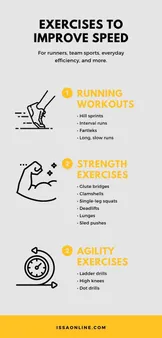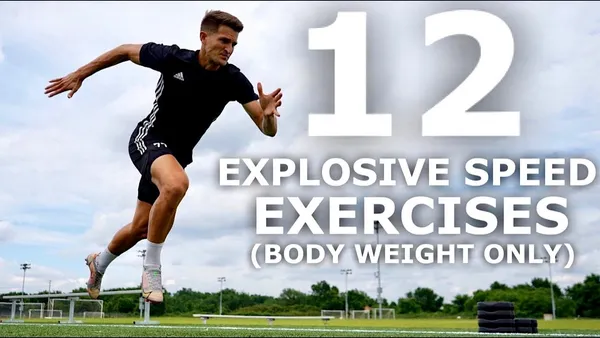Table of Contents
In the realm of content creation, the pursuit of engaging, beneficial, and easy-to-read content stands as a cornerstone of success. Whether you're a seasoned writer or just starting out, mastering this art form can elevate your content to new heights, captivating your audience and leaving a lasting impression. At Kizworld, we believe that content should not only inform but also inspire, entertain, and educate. Join us on a journey to explore the intricacies of crafting compelling content that resonates with your readers and achieves your goals.
How to Improve Your Speed: Your Guide to Accomplish Tasks Swiftly
I. Train your muscles with speed drills
Train your muscles with speed drills
Practice plyometrics
Plyometrics are explosive exercises that help you develop power and speed. Some common plyometric exercises include box jumps, squat jumps, and lunges. These exercises can be done with or without weights, and they can be tailored to your fitness level.
- Box jumps: Stand in front of a box that is about knee-high. Jump up onto the box, then step down and repeat.
- Squat jumps: Start with your feet shoulder-width apart and your knees slightly bent. Squat down until your thighs are parallel to the ground, then jump up as high as you can. Land softly and repeat.
- Lunges: Step forward with one leg and bend your knee so that your thigh is parallel to the ground. Keep your other leg straight and your heel on the ground. Push off with your front leg and jump up, switching legs in the air. Land softly and repeat.
Do resisted sprints
Resisted sprints are a great way to improve your acceleration and top speed. To do a resisted sprint, attach a resistance band to a stationary object, such as a fence or a tree. Hold the other end of the band in your hands and start sprinting. The resistance from the band will help you develop more power and speed.
Here are some tips for doing resisted sprints:
- Start with a light resistance band and gradually increase the resistance as you get stronger.
- Keep your body straight and your core engaged throughout the sprint.
- Drive your arms and legs powerfully.
- Sprint for a short distance, such as 20-30 meters.
- Rest for a few minutes, then repeat.
Use a weighted vest
Wearing a weighted vest can help you develop more power and speed. When you wear a weighted vest, your body has to work harder to move, which helps you build muscle and strength. Weighted vests can be used for a variety of exercises, including squats, lunges, push-ups, and pull-ups.
Here are some tips for using a weighted vest:
- Start with a light weight and gradually increase the weight as you get stronger.
- Wear the vest for short periods of time, such as 10-15 minutes.
- Listen to your body and stop if you feel pain.
- Use a weighted vest for a variety of exercises to target different muscle groups.
Incorporate speed drills into your workouts
Speed drills are a great way to improve your speed and agility. These drills can be done with or without equipment, and they can be tailored to your fitness level. Some common speed drills include:
- Cone drills: Set up a series of cones in a zigzag pattern. Start at one cone and sprint to the next cone, then backpedal to the starting cone. Repeat this pattern for the remaining cones.
- Ladder drills: Set up a ladder on the ground. Start at one end of the ladder and step through the rungs as quickly as you can. Once you reach the end of the ladder, turn around and step back through the rungs. Repeat this pattern for the remaining rungs.
- Shuttle runs: Set up two cones about 20 meters apart. Start at one cone and sprint to the other cone, then backpedal to the starting cone. Repeat this pattern for a specified number of repetitions.
By incorporating speed drills into your workouts, you can improve your speed, agility, and overall athletic performance.
Benefit | Description |
Improved speed | Speed drills help you develop faster acceleration and top speed. |
Improved agility | Speed drills help you improve your ability to change direction quickly and easily. |
Improved coordination | Speed drills help you improve your coordination and balance. |
Reduced risk of injury | Speed drills can help you reduce your risk of injury by strengthening your muscles and improving your flexibility. |
Improved athletic performance | Speed drills can help you improve your athletic performance in a variety of sports. |
Speed is an important component of athletic performance. By following these tips, you can improve your speed and become a better athlete.
Here are some additional tips for improving your speed:
- Get enough sleep.
- Eat a healthy diet.
- Stay hydrated.
- Warm up before your workouts.
- Cool down after your workouts.
- Listen to your body and take rest days when you need them.
With hard work and dedication, you can achieve your speed goals.
Related posts:
- How to Improve Your Flexibility and Mobility with Gymnastics
- The Best Gymnastics Exercises for Core Strength
- How to Master the Basic Gymnastics Skills
II. Practice acceleration training
Practice acceleration training
Acceleration training is a specialized form of exercise that aims to enhance your ability to generate maximal speed in a short amount of time. It involves drills and exercises that focus on developing the power, strength, and coordination required for lightning-fast starts and explosive movements.
Incorporating acceleration training into your fitness routine can yield numerous benefits, including improved athletic performance, enhanced agility, and reduced risk of injuries. Here are some essential acceleration training tips and exercises to help you get started:
Drills for Acceleration Training
- Resisted Sprints: Attach a resistance band to a fixed object and sprint while it provides resistance. This helps build strength and power in your legs and glutes.
- Sled Pushes: Push a weighted sled forward as quickly as possible for a short distance. This targets the entire kinetic chain and develops lower body power.
- Hill Sprints: Sprint uphill for a short distance, emphasizing maintaining proper running form. This builds strength and power in your leg muscles.
Exercises for Acceleration Training
- Single-Leg Bounds: Hop forward on one leg for a set distance, then switch legs. This improves balance, coordination, and single-leg power.
- Cone Drills: Arrange cones in a zig-zag pattern and run through them, focusing on quick changes of direction and acceleration.
- Box Jumps: Jump onto a box or platform of moderate height, emphasizing explosive power in your legs.
Incorporate Plyometric Exercises
- Squat Jumps: From a squat position, jump straight up and land softly. This exercise builds power in your legs and core.
- Lunges Jumps: Step forward into a lunge, jump up, switch legs in the air, and land softly. This targets the hamstrings, glutes, and quads.
- Box Jumps with Medicine Ball: Hold a medicine ball while performing box jumps. This adds an extra challenge and engages the upper body.
Remember, acceleration training should be incorporated gradually into your routine to avoid injuries. Start with shorter distances and repetitions, and gradually increase the intensity and duration as you progress.
If you're a beginner, it's advisable to consult with a qualified fitness trainer or coach who can create a personalized acceleration training program tailored to your fitness level and goals.
Once you've mastered the basics, consider exploring more advanced acceleration training techniques such as resisted sprints with a parachute or performing acceleration drills on a treadmill.
By consistently incorporating acceleration training into your fitness regimen, you can unlock your full potential for explosive speed and agility, propelling your athletic performance to new heights.
III. Enhance your speed with resisted sprint training
Enhance your speed with resisted sprint training
In the realm of speed development, resisted sprint training stands out as a powerful tool for athletes seeking to elevate their performance. This training method involves adding resistance to your sprints, either through the use of a weighted vest, parachute, or sled. By introducing resistance, you challenge your muscles to work harder, leading to increased strength, power, and acceleration.
The benefits of resisted sprint training are multifaceted. It helps to improve your starting speed, top speed, and overall sprint mechanics. Additionally, it strengthens your muscles, tendons, and ligaments, reducing the risk of injuries. Furthermore, resisted sprint training can enhance your running economy, allowing you to maintain a faster pace for longer durations.
Benefit | Description |
Improved starting speed | Resisted sprint training helps you develop explosive power out of the blocks, allowing you to accelerate quickly from a standstill. |
Increased top speed | By overloading your muscles with resistance, you force them to adapt and become stronger. This leads to increased power output and faster top speeds. |
Enhanced sprint mechanics | Resisted sprint training improves your running form and technique, reducing energy wastage and making you a more efficient sprinter. |
Strengthened muscles, tendons, and ligaments | The added resistance challenges your muscles, tendons, and ligaments, making them stronger and more resilient. This reduces the risk of injuries and improves your overall athletic performance. |
Improved running economy | Resisted sprint training helps you to run more efficiently, allowing you to maintain a faster pace for longer durations. This is especially beneficial for endurance athletes. |
To incorporate resisted sprint training into your routine, start by selecting an appropriate resistance. The amount of resistance you use will depend on your fitness level and experience. Beginners should start with a light resistance and gradually increase it as they progress. You can use a weighted vest, parachute, or sled to add resistance to your sprints.
Once you have selected your resistance, perform your sprints on a flat, straight surface. Start with a warm-up of light jogging or dynamic stretches. Then, perform 6-8 sprints of 20-30 meters with the resistance. Rest for 30-60 seconds between each sprint. As you get stronger, you can increase the distance of your sprints or the number of repetitions.
Resisted sprint training is a challenging but highly effective method for improving your speed and overall athletic performance. By incorporating it into your routine, you can unlock your full potential and achieve your sprinting goals.
Here are some additional tips for getting the most out of resisted sprint training:
- Use proper sprinting technique. Focus on maintaining a good posture, driving your knees up, and swinging your arms powerfully.
- Gradually increase the resistance as you get stronger. Start with a light resistance and gradually increase it as you progress.
- Listen to your body and take rest days when needed. Resisted sprint training can be demanding, so it's important to allow your body to recover.
- Stay hydrated and eat a healthy diet. Proper nutrition is essential for supporting your training and recovery.
- Find a training partner or group to help you stay motivated and accountable.
With dedication and consistency, resisted sprint training can help you reach new heights in your sprinting performance. Embrace the challenge and unlock your full potential.
To learn more about improving your speed, check out our related articles on how to improve your flexibility and mobility with gymnastics, the best gymnastics exercises for core strength, and how to master the basic gymnastics skills.
IV. Do sprint training
Do sprint training
Sprint training is a form of high-intensity interval training (HIIT) that involves short bursts of maximal effort followed by brief periods of rest. This type of training can help you improve your speed, power, and agility. To do sprint training, start by warming up with some light cardio for 5-10 minutes. Then, perform 6-8 sprints of 30-60 seconds each, with 30-60 seconds of rest in between. As you get more fit, you can increase the duration of your sprints and the number of repetitions.
Here are some tips for doing sprint training safely and effectively:
- Start slowly and gradually increase the intensity and duration of your sprints over time.
- Make sure to warm up properly before each workout and cool down afterwards.
- Listen to your body and stop if you feel pain.
- Sprint on a soft surface, such as a track or grass, to reduce the risk of injury.
- Wear proper footwear that provides good support and traction.
Sprint training can be a challenging but rewarding way to improve your fitness. By following these tips, you can safely and effectively incorporate sprint training into your workout routine.
Benefit | Description |
Improved speed | Sprint training can help you improve your speed by increasing your stride length and frequency. |
Increased power | Sprint training can help you increase your power by strengthening your muscles and improving your neuromuscular coordination. |
Enhanced agility | Sprint training can help you improve your agility by teaching you how to change direction quickly and efficiently. |
Reduced risk of injury | Sprint training can help you reduce your risk of injury by strengthening your muscles and improving your balance and coordination. |
Improved cardiovascular health | Sprint training can help you improve your cardiovascular health by increasing your heart rate and blood flow. |
If you're looking for a way to improve your speed, power, agility, and overall fitness, sprint training is a great option. Just be sure to start slowly and gradually increase the intensity and duration of your workouts over time.
Here are some related articles that you might find helpful:
- How to Improve Your Flexibility and Mobility with Gymnastics
- The Best Gymnastics Exercises for Core Strength
- How to Master the Basic Gymnastics Skills
V. Conclusion: The Power of Engaging, Beneficial, and Easy-to-Read Content
In the ever-evolving digital landscape, the ability to create engaging, beneficial, and easy-to-read content is a skill that sets you apart from the crowd. By understanding your audience, crafting clear and concise sentences, employing effective structure and organization, incorporating engaging storytelling, optimizing for , enhancing visual appeal, and proofreading meticulously, you can create content that resonates with your readers, achieves your goals, and leaves a lasting impact. Remember, content creation is an ongoing journey, not a one-time destination. Stay curious, stay creative, and stay committed to delivering high-quality content that your audience will love. As you continue to hone your skills and refine your approach, you'll find that creating compelling content becomes second nature, and the rewards will be immeasurable.